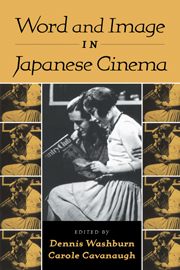Book contents
- Frontmatter
- Contents
- List of Illustrations
- Contributors
- Foreword: Outside Views of the Japanese Film
- Introduction
- PART ONE WORDING THE IMAGE/IMAGING THE WORD
- 1 The Word before the Image: Criticism, the Screenplay, and the Regulation of Meaning in Prewar Japanese Film Culture
- 2 The Cinematic Art of Higuchi Ichiyô's Takekurabe (Comparing Heights, 1895–1896)
- 3 Once More and Gosho's Romanticism in the Early Occupation Period
- 4 The Taunt of the Gods: Reflections on Woman In The Dunes
- 5 Adapting The Makioka Sisters
- 6 In the Show House of Modernity: Exhaustive Listing in Itami Jûzô's Tanpopo
- PART TWO REFLECTIONS OF IDENTITY
- PART THREE OUTSIDE THE FRAME OF CULTURE
- Selected Bibliography of Articles and Books in English
- Index
2 - The Cinematic Art of Higuchi Ichiyô's Takekurabe (Comparing Heights, 1895–1896)
Published online by Cambridge University Press: 01 March 2010
- Frontmatter
- Contents
- List of Illustrations
- Contributors
- Foreword: Outside Views of the Japanese Film
- Introduction
- PART ONE WORDING THE IMAGE/IMAGING THE WORD
- 1 The Word before the Image: Criticism, the Screenplay, and the Regulation of Meaning in Prewar Japanese Film Culture
- 2 The Cinematic Art of Higuchi Ichiyô's Takekurabe (Comparing Heights, 1895–1896)
- 3 Once More and Gosho's Romanticism in the Early Occupation Period
- 4 The Taunt of the Gods: Reflections on Woman In The Dunes
- 5 Adapting The Makioka Sisters
- 6 In the Show House of Modernity: Exhaustive Listing in Itami Jûzô's Tanpopo
- PART TWO REFLECTIONS OF IDENTITY
- PART THREE OUTSIDE THE FRAME OF CULTURE
- Selected Bibliography of Articles and Books in English
- Index
Summary
In Section 3 of her master work, Takekurabe, Higuchi Ichiyô (1872–96) has one of her adolescent characters, Shôta, suggest to another, Midori, that they put on, as their contribution to the forthcoming neighborhood Otori Festival, a magic lantern (gentô) show. He goes on to suggest that they ask another character, Sangorô, who is talented as a street-hawker and can make people laugh with his chatter, to do a running narration (kôjô) to accompany the performance. Regrettably, this magic-lantern performance never takes place – but the mention of it places Ichiyô's story firmly in the historical context of the mid–Meiji introduction from Europe of popular entertainments anticipating the cinema. The magic lantern (gentô), or stereopticon, was “introduced into Japan in 1874 as a toy.” “Lantern-slide shows had been touring Japan from 1886, and as early as 1893 an Italian had brought something called a ‘kinematograph’ show to Nagasaki,” which was accompanied by ‘live narration.’“
By the time Ichiyô wrote Takekurabe in 1895–1896, home magiclantern performances of the sort planned by Shôta and Midori had become a common form of entertainment for bourgeois families such as Shôta's. It is significant that Shôta's and Midori's plans include two aspects of what was later to become cinema: projection of images to an audience watching in the dark, and explanation and commentary (kôjô) by a live narrator – who would, in cinema, be called a benshi (narrator/ commentator).
- Type
- Chapter
- Information
- Word and Image in Japanese Cinema , pp. 36 - 58Publisher: Cambridge University PressPrint publication year: 2000



